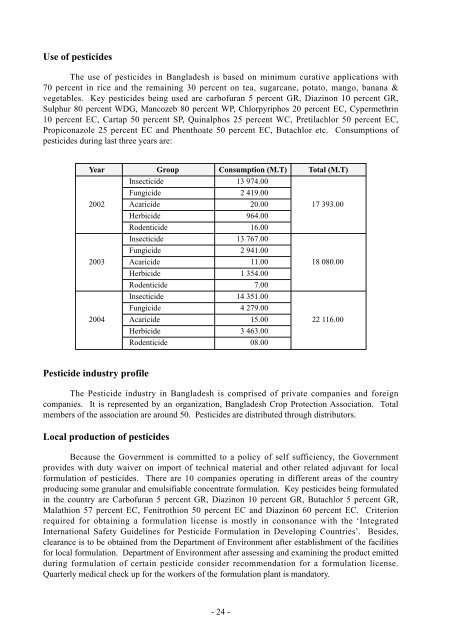Proceedings of the Asia regional workshop on the
Proceedings of the Asia regional workshop on the
Proceedings of the Asia regional workshop on the
You also want an ePaper? Increase the reach of your titles
YUMPU automatically turns print PDFs into web optimized ePapers that Google loves.
Use <str<strong>on</strong>g>of</str<strong>on</strong>g> pesticides<br />
The use <str<strong>on</strong>g>of</str<strong>on</strong>g> pesticides in Bangladesh is based <strong>on</strong> minimum curative applicati<strong>on</strong>s with<br />
70 percent in rice and <str<strong>on</strong>g>the</str<strong>on</strong>g> remaining 30 percent <strong>on</strong> tea, sugarcane, potato, mango, banana &<br />
vegetables. Key pesticides being used are carb<str<strong>on</strong>g>of</str<strong>on</strong>g>uran 5 percent GR, Diazin<strong>on</strong> 10 percent GR,<br />
Sulphur 80 percent WDG, Mancozeb 80 percent WP, Chlorpyriphos 20 percent EC, Cypermethrin<br />
10 percent EC, Cartap 50 percent SP, Quinalphos 25 percent WC, Pretilachlor 50 percent EC,<br />
Propic<strong>on</strong>azole 25 percent EC and Phenthoate 50 percent EC, Butachlor etc. C<strong>on</strong>sumpti<strong>on</strong>s <str<strong>on</strong>g>of</str<strong>on</strong>g><br />
pesticides during last three years are:<br />
Year Group C<strong>on</strong>sumpti<strong>on</strong> (M.T) Total (M.T)<br />
Insecticide 13 974.00<br />
Fungicide 2 419.00<br />
2002 Acaricide 20.00 17 393.00<br />
Herbicide 964.00<br />
Rodenticide 16.00<br />
Insecticide 13 767.00<br />
Fungicide 2 941.00<br />
2003 Acaricide 11.00 18 080.00<br />
Herbicide 1 354.00<br />
Rodenticide 7.00<br />
Insecticide 14 351.00<br />
Fungicide 4 279.00<br />
2004 Acaricide 15.00 22 116.00<br />
Herbicide 3 463.00<br />
Rodenticide 08.00<br />
Pesticide industry pr<str<strong>on</strong>g>of</str<strong>on</strong>g>ile<br />
The Pesticide industry in Bangladesh is comprised <str<strong>on</strong>g>of</str<strong>on</strong>g> private companies and foreign<br />
companies. It is represented by an organizati<strong>on</strong>, Bangladesh Crop Protecti<strong>on</strong> Associati<strong>on</strong>. Total<br />
members <str<strong>on</strong>g>of</str<strong>on</strong>g> <str<strong>on</strong>g>the</str<strong>on</strong>g> associati<strong>on</strong> are around 50. Pesticides are distributed through distributors.<br />
Local producti<strong>on</strong> <str<strong>on</strong>g>of</str<strong>on</strong>g> pesticides<br />
Because <str<strong>on</strong>g>the</str<strong>on</strong>g> Government is committed to a policy <str<strong>on</strong>g>of</str<strong>on</strong>g> self sufficiency, <str<strong>on</strong>g>the</str<strong>on</strong>g> Government<br />
provides with duty waiver <strong>on</strong> import <str<strong>on</strong>g>of</str<strong>on</strong>g> technical material and o<str<strong>on</strong>g>the</str<strong>on</strong>g>r related adjuvant for local<br />
formulati<strong>on</strong> <str<strong>on</strong>g>of</str<strong>on</strong>g> pesticides. There are 10 companies operating in different areas <str<strong>on</strong>g>of</str<strong>on</strong>g> <str<strong>on</strong>g>the</str<strong>on</strong>g> country<br />
producing some granular and emulsifiable c<strong>on</strong>centrate formulati<strong>on</strong>. Key pesticides being formulated<br />
in <str<strong>on</strong>g>the</str<strong>on</strong>g> country are Carb<str<strong>on</strong>g>of</str<strong>on</strong>g>uran 5 percent GR, Diazin<strong>on</strong> 10 percent GR, Butachlor 5 percent GR,<br />
Malathi<strong>on</strong> 57 percent EC, Fenitrothi<strong>on</strong> 50 percent EC and Diazin<strong>on</strong> 60 percent EC. Criteri<strong>on</strong><br />
required for obtaining a formulati<strong>on</strong> license is mostly in c<strong>on</strong>s<strong>on</strong>ance with <str<strong>on</strong>g>the</str<strong>on</strong>g> ‘Integrated<br />
Internati<strong>on</strong>al Safety Guidelines for Pesticide Formulati<strong>on</strong> in Developing Countries’. Besides,<br />
clearance is to be obtained from <str<strong>on</strong>g>the</str<strong>on</strong>g> Department <str<strong>on</strong>g>of</str<strong>on</strong>g> Envir<strong>on</strong>ment after establishment <str<strong>on</strong>g>of</str<strong>on</strong>g> <str<strong>on</strong>g>the</str<strong>on</strong>g> facilities<br />
for local formulati<strong>on</strong>. Department <str<strong>on</strong>g>of</str<strong>on</strong>g> Envir<strong>on</strong>ment after assessing and examining <str<strong>on</strong>g>the</str<strong>on</strong>g> product emitted<br />
during formulati<strong>on</strong> <str<strong>on</strong>g>of</str<strong>on</strong>g> certain pesticide c<strong>on</strong>sider recommendati<strong>on</strong> for a formulati<strong>on</strong> license.<br />
Quarterly medical check up for <str<strong>on</strong>g>the</str<strong>on</strong>g> workers <str<strong>on</strong>g>of</str<strong>on</strong>g> <str<strong>on</strong>g>the</str<strong>on</strong>g> formulati<strong>on</strong> plant is mandatory.<br />
- 24 -

















